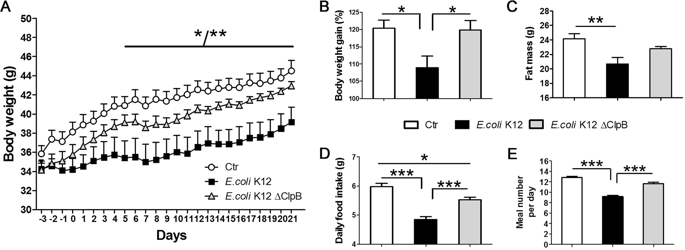当前位置:
X-MOL 学术
›
Int. J. Obesity
›
论文详情
Our official English website, www.x-mol.net, welcomes your feedback! (Note: you will need to create a separate account there.)
Commensal Hafnia alvei strain reduces food intake and fat mass in obese mice-a new potential probiotic for appetite and body weight management.
International Journal of Obesity ( IF 4.9 ) Pub Date : 2020-01-07 , DOI: 10.1038/s41366-019-0515-9 Romain Legrand 1 , Nicolas Lucas 1 , Manon Dominique 1, 2, 3 , Saida Azhar 1 , Camille Deroissart 1, 2, 3 , Marie-Anne Le Solliec 1, 2, 3 , Julie Rondeaux 1, 2, 3 , Séverine Nobis 2, 3 , Charlène Guérin 2, 3 , Fatima Léon 3, 4 , Jean-Claude do Rego 3, 4 , Nicolas Pons 5 , Emmanuelle Le Chatelier 5 , S Dusko Ehrlich 5 , Gregory Lambert 1 , Pierre Déchelotte 1, 2, 3, 6 , Sergueï O Fetissov 1, 2, 3, 7
International Journal of Obesity ( IF 4.9 ) Pub Date : 2020-01-07 , DOI: 10.1038/s41366-019-0515-9 Romain Legrand 1 , Nicolas Lucas 1 , Manon Dominique 1, 2, 3 , Saida Azhar 1 , Camille Deroissart 1, 2, 3 , Marie-Anne Le Solliec 1, 2, 3 , Julie Rondeaux 1, 2, 3 , Séverine Nobis 2, 3 , Charlène Guérin 2, 3 , Fatima Léon 3, 4 , Jean-Claude do Rego 3, 4 , Nicolas Pons 5 , Emmanuelle Le Chatelier 5 , S Dusko Ehrlich 5 , Gregory Lambert 1 , Pierre Déchelotte 1, 2, 3, 6 , Sergueï O Fetissov 1, 2, 3, 7
Affiliation

|
BACKGROUND/OBJECTIVES
Based on the recent identification of E.coli heat shock protein ClpB as a mimetic of the anorexigenic α-melanocyte stimulating hormone (α-MSH), the objective of this study was to preclinically validate Hafnia alvei, a ClpB-producing commensal bacterium as a potential probiotic for appetite and body weight management in overweight and obesity.
METHODS
The involvement of enterobacterial ClpB in the putative anti-obesity effects was studied using ClpB-deficient E.coli. A food-grade H. alvei HA4597 strain synthetizing the ClpB protein with an α-MSH-like motif was selected as a candidate probiotic to be tested in ob/ob and high-fat diet (HFD)-fed obese and overweight mice. The relevance of the enterobacterial ClpB gene to human obesity was studied by in silico analysis of fecal metagenomes of 569 healthy individuals from the "MetaHIT" database.
RESULTS
Chronic per os administration of native but not ClpB-deficient E.coli strain reduced body weight gain (p < 0.05) and daily meal frequency (p < 0.001) in ob/ob mice. Oral gavage of H.alvei for 18 and 46 days in ob/ob and HFD-fed obese mice, respectively, was well tolerated, reduced body weight gain and fat mass in both obesity models (p < 0.05) and decreased food intake in hyperphagic ob/ob mice (p < 0.001). Elevated fat tissue levels of phosphorylated hormone-sensitive lipase were detected in H.alvei -treated ob/ob mice (p < 0.01). Enterobacterial ClpB gene richness was lower in obese vs. non-obese humans (p < 0.0001) and correlated negatively with BMI in genera of Enterobacter, Klebsiella and Hafnia.
CONCLUSIONS
H.alvei HA4597 strain reduces food intake, body weight and fat mass gain in hyperphagic and obese mice. These data combined with low enterobacterial ClpB gene abundance in the microbiota of obese humans provide the rationale for using H.alvei as a probiotic for appetite and body weight management in overweight and obesity.
中文翻译:

共生 Hafnia alvei 菌株减少了肥胖小鼠的食物摄入量和脂肪量——一种用于食欲和体重管理的新潜在益生菌。
背景/目的 基于最近鉴定的大肠杆菌热休克蛋白 ClpB 是促食欲的 α-促黑素细胞激素 (α-MSH) 的模拟物,本研究的目的是在临床前验证 Hafnia alvei,一种产生 ClpB 的共生菌细菌作为一种潜在的益生菌,可用于超重和肥胖症的食欲和体重管理。方法 使用缺乏 ClpB 的大肠杆菌研究肠杆菌 ClpB 在推定的抗肥胖作用中的作用。选择合成具有 α-MSH 样基序的 ClpB 蛋白的食品级 H. alvei HA4597 菌株作为候选益生菌,在 ob/ob 和高脂肪饮食 (HFD) 喂养的肥胖和超重小鼠中进行测试。通过计算机分析来自“MetaHIT”数据库的 569 名健康个体的粪便宏基因组,研究了肠杆菌 ClpB 基因与人类肥胖的相关性。结果 长期口服施用天然而非 ClpB 缺陷型大肠杆菌菌株可降低 ob/ob 小鼠的体重增加 (p < 0.05) 和每日进餐频率 (p < 0.001)。分别在 ob/ob 和 HFD 喂养的肥胖小鼠中口服灌胃 H.alvei 18 天和 46 天,耐受性良好,降低了两种肥胖模型的体重增加和脂肪量(p < 0.05),并减少了过度摄食的食物摄入量。 ob/ob 小鼠 (p < 0.001)。在 H.alvei 处理的 ob/ob 小鼠中检测到磷酸化激素敏感性脂肪酶的脂肪组织水平升高(p < 0.01)。肥胖人群的肠杆菌 ClpB 基因丰富度低于非肥胖人群(p < 0。0001) 并与肠杆菌属、克雷伯氏菌属和哈夫尼亚菌属的 BMI 呈负相关。结论 H.alvei HA4597 菌株减少了过度进食和肥胖小鼠的食物摄入量、体重和脂肪量增加。这些数据与肥胖人类微生物群中的低肠杆菌 ClpB 基因丰度相结合,为使用 H.alvei 作为超重和肥胖患者的食欲和体重管理益生菌提供了依据。
更新日期:2020-01-07
中文翻译:

共生 Hafnia alvei 菌株减少了肥胖小鼠的食物摄入量和脂肪量——一种用于食欲和体重管理的新潜在益生菌。
背景/目的 基于最近鉴定的大肠杆菌热休克蛋白 ClpB 是促食欲的 α-促黑素细胞激素 (α-MSH) 的模拟物,本研究的目的是在临床前验证 Hafnia alvei,一种产生 ClpB 的共生菌细菌作为一种潜在的益生菌,可用于超重和肥胖症的食欲和体重管理。方法 使用缺乏 ClpB 的大肠杆菌研究肠杆菌 ClpB 在推定的抗肥胖作用中的作用。选择合成具有 α-MSH 样基序的 ClpB 蛋白的食品级 H. alvei HA4597 菌株作为候选益生菌,在 ob/ob 和高脂肪饮食 (HFD) 喂养的肥胖和超重小鼠中进行测试。通过计算机分析来自“MetaHIT”数据库的 569 名健康个体的粪便宏基因组,研究了肠杆菌 ClpB 基因与人类肥胖的相关性。结果 长期口服施用天然而非 ClpB 缺陷型大肠杆菌菌株可降低 ob/ob 小鼠的体重增加 (p < 0.05) 和每日进餐频率 (p < 0.001)。分别在 ob/ob 和 HFD 喂养的肥胖小鼠中口服灌胃 H.alvei 18 天和 46 天,耐受性良好,降低了两种肥胖模型的体重增加和脂肪量(p < 0.05),并减少了过度摄食的食物摄入量。 ob/ob 小鼠 (p < 0.001)。在 H.alvei 处理的 ob/ob 小鼠中检测到磷酸化激素敏感性脂肪酶的脂肪组织水平升高(p < 0.01)。肥胖人群的肠杆菌 ClpB 基因丰富度低于非肥胖人群(p < 0。0001) 并与肠杆菌属、克雷伯氏菌属和哈夫尼亚菌属的 BMI 呈负相关。结论 H.alvei HA4597 菌株减少了过度进食和肥胖小鼠的食物摄入量、体重和脂肪量增加。这些数据与肥胖人类微生物群中的低肠杆菌 ClpB 基因丰度相结合,为使用 H.alvei 作为超重和肥胖患者的食欲和体重管理益生菌提供了依据。


























 京公网安备 11010802027423号
京公网安备 11010802027423号